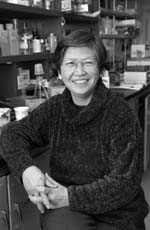| Fall 2004 |
||
| PREVIOUS|PAGE 1 | ||
| Figuring Out an Unknown: Students Ask More Questions When They Already Know the Answer Charlotte K. Omoto |
 |
|
It is now well established that well designed inquiry-based laboratory exercises provoke students to ask their own questions and promote higher-level learning than traditional “cookbook” laboratory exercises. Yet we also need to teach students some basic techniques and procedures that seem to beg for a “cookbook” type approach. I describe here a simple modification of a laboratory exercise that encourages student to generate questions. Student-generated questions are recognized to be a good way to improve comprehension (Rosenshine et al., 1996). Early in the semester in my cell physiology laboratory class, I use a protein assay to introduce students to the proper use of the spectrophotometer, micropipettors, dilutions, and attendant calculation. Originally, I provided the students with a stock protein solution of known concentration from which they made their standard curve, and then another protein solution for which the concentration was not given. The students would then perform the protein assay and determine the concentration of the unknown. I soon realized that students were very keen to find out if they got the “right” concentration of the unknown. If they did, they were happy; if they didn’t, they were not, but there was no exploration of what they might have done wrong. What’s more, students who got the right answer may have done so by chance rather than by proper use of techniques. There were no further questions or investigations of the procedures and techniques that they should have learned. Therefore, I revised my protein assay exercise in an effort to engage the students more. Rather than me, the “almighty instructor,” handing them an unknown, I have the students make their own “unknown” from the stock protein concentration. Thus they already know what the “right” answer is. With this design of the laboratory, students no longer ask whether they got the right answer and have that be the dead-end to their inquiry. Students instead generate more meaningful questions that lead to further inquiry and deeper comprehension of the procedures they are learning. Students in my class have asked such questions as:
This leads to further questions, such as:
Students themselves asked these questions of their fellow classmates and the instructor. Asking such questions shows higher-level thinking and deeper appreciation for all components of the laboratory exercise. Students are engaged to answer the questions of their classmates. Even those who did the exercise properly and got a great linear regression of their standard curve and very close estimate of the protein concentration were interested in the questions and participated in the discussion. With this redesigned introduction to protein assays, students are much more aware of proper procedures and potential sources for error when they are determining the concentration of an unknown in later experiments. I believe that this general approach to students generating or knowing the answer can be used in a variety of settings. For example, I use an analogous approach to teach Mendelian Genetics and pedigree analysis (Omoto, 1997). In this case, students generate a pedigree and thus know the genotype and they assess whether the rules of inheritance can be determined from the pedigree that they generated. Literature Cited:
|
||
| PREVIOUS|PAGE 1 | ||